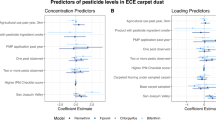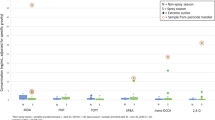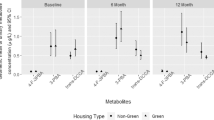Abstract
We conducted a randomized-controlled trial of a home-based intervention to reduce pesticide exposures to farmworkers’ children in Monterey County, California (n=116 families). The intervention consisted of three home-based educational sessions delivered by community health workers in Spanish. Measurements of organophosphate (OP) insecticide metabolites in child urine (n=106) and pesticides in home floor wipes (n=103) were collected before and after the intervention. Median child urinary dialkyl phosphate (DAP) metabolite levels were slightly lower among the intervention group children at follow-up compared with baseline, albeit nonsignificantly. DAP metabolite levels in the control group children were markedly higher at follow-up compared with baseline. In adjusted models, intervention participation was associated with a 51% decrease in total DAP metabolite levels. Carbaryl, chlorpyrifos, cypermethrin, dacthal, diazinon, malathion, and trans-permethrin were commonly detected in the floor wipes. In adjusted models, intervention participation was significantly associated with a 37% decrease in trans-permethrin floor wipe levels in homes, but not OP or other agricultural pesticides. In summary, intervention group children had slightly reduced pesticide exposures, whereas child exposures were higher among the control group. Additional intervention studies evaluating methods to reduce pesticide exposures to farmworker families and children are needed.
This is a preview of subscription content, access via your institution
Access options
Subscribe to this journal
Receive 6 print issues and online access
$259.00 per year
only $43.17 per issue
Buy this article
- Purchase on Springer Link
- Instant access to full article PDF
Prices may be subject to local taxes which are calculated during checkout
Similar content being viewed by others
References
Bradman A, Whitaker D, Quiros L, Castorina R, Claus Henn B, Nishioka M et al. Pesticides and their metabolites in the homes and urine of farmworker children living in the Salinas Valley, CA. J Exp Sci Environ Epidemiol 2007; 17: 331–349.
Landrigan PJ, Claudio L, Markowitz SB, Berkowitz GS, Brenner BL, Romero H . Pesticides and inner-city children: exposures, risks, and prevention. Environ Health Perspect 1999; 107 (Suppl 3): 431–437.
McCauley LA, Michaels S, Rothlein J, Muniz J, Lasarev M, Ebbert C . Pesticide exposure and self-reported home hygiene: practices in agricultural famlies. AAOHN 2003; 51: 113–119.
Quandt SA, Arcury TA, Rao P, Snively BM, Camann DE, Doran AM et al. Agricultural and residential pesticides in wipe samples from farmworker family residences in North Carolina and Virginia. Environ Health Perspect 2004; 112: 382–387.
NAS (National Academy of Sciences) Pesticides in the Diets of Infants and Children. National Academy of Sciences: : Washington, DC, USA. 1993.
Eskenazi B, Bradman A, Castorina R . Exposures of children to organophosphate pesticides and their potential adverse health effects. Environ Health Perspect 1999; 107 (Suppl 3): 409–419.
Arcury TA, Quandt SA, Rao P, Doran A, Snively BM, Davis S et al. Organophosphate pesticide exposure in farmworker family members in western North Carolina and Virgina: Case comparisons. Hum Organ 2005; 64: 40–51.
Bradman A, Salvatore AL, Boeniger M, Castorina R, Snyder J, Barr DB et al. Community-based intervention to reduce pesticide exposure to farmworkers and potential take-home exposure to their families. J Exp Sci Environ Epidemiol 2009; 19: 79–89.
Lu C, Fenske RA, Simcox NJ, Kalman D . Pesticide exposure of children in an agricultural community: evidence of household proximity to farmland and take home exposure pathways. Environ Res 2000; 84: 290–302.
McCauley LA, Lasarev MR, Higgins G, Rothlein J, Muniz J, Ebbert C et al. Work characteristics and pesticide exposures among migrant agricultural families: a community-based research approach. Environ Health Perspect 2001; 109: 533–538.
Coronado GD, Thompson B, Strong L, Griffith WC, Islas I . Agricultural task and exposure to organophosphate pesticides among farmworkers. Environ Health Perspect 2004; 112: 142–147.
Arcury TA, Marin A, Snively BM, Hernandez-Pelletier M, Quandt SA . Reducing farmworker residential pesticide exposure: evaluation of a lay health advisor intervention. Health Promot Pract 2009; 10: 447–455.
Liebman AK, Juárez PM, Leyva C, Corona A . A pilot program using promotoras de salud to educate farmworker families about the risks from pesticide exposure. J Agromedicine 2007; 12: 33–43.
Thompson B, Coronado GD, Vigoren EM, Griffith WC, Fenske RA, Kissel JC et al. Para ninos saludables: a community intervention trial to reduce organophosphate pesticide exposure in children of farmworkers. Environ Health Perspect 2008; 116: 687–694.
Salvatore AL, Chevrier J, Bradman A, Camacho J, Lopez J, Kavanagh-Baird G et al. A community-based participatory worksite intervention to reduce pesticide exposures to farmworkers and their families. Am J Public Health 2009; 99 (Suppl 3): S578–S581.
Strong LL, Thompson B, Koepsell TD, Meischke H, Coronado GD . Reducing the take-home pathway of pesticide exposure: behavioral outcomes from the Para Ninos Saludables study. J Occup Environ Med 2009; 51: 922–933.
Quandt SA, Grzywacz JG, Talton JW, Trejo G, Tapia J, D'Agostino RB, Jr. et al. Evaluating the effectiveness of a lay health promoter-led, community-based participatory pesticide safety intervention with farmworker families. Health Promot Pract 2013; 14: 425–432.
Green LW, George MA, Daniel M, Frankish CJ, Herbert CP, Bowie WR et al. Study of Participatory Research in Health Promotion. Royal Society of Canada: Ottawa, ON, USA. 1995.
Israel BA, Parker EA, Rowe Z, Salvatore A, Minkler M, Lopez J et al. Community-based participatory research: lessons learned from the Centers for Children's Environmental Health and Disease Prevention Research. Environ Health Perspect 2005; 113: 1463–1471.
Eskenazi B, Bradman A, Gladstone EA, Jaramillo S, Birch K, Holland NT . CHAMACOS, A longitudinal birth cohort study: Lessons from the Fields. J Child Health 2003; 1: 3–27.
CDPR (California Department of Pesticide Regulation) Pesticide Use Report 2004, Indexed by Chemical and by Crop, Department of Pesticide Regulation. California Environmental Protection Agency: Sacramento. 2004.
Bradman A, Chevrier J, Tager I, Lipsett M, Sedgwick J, Macher J et al. Association of housing disrepair indicators with cockroach and rodent infestations in a cohort of pregnant Latina women and their children. Environ Health Perspect 2005; 113: 1795–1801.
Champion VL, Skinner CS . The health belief model. Glanz K, Rimer BK, Viswanath K (eds). Health behavior and health education. 4th edn. John Wiley and Sons, Inc.: San Francisco, CA. 2008, pp 45–65.
McAlister AL, Perry CL, Parcel GS . How individuals, environments, and health behaviors interact: social cognitive theory. Glanz K, Rimer BK, Viswanath K (eds). Health behavior and health education. theory, research, and practice. 4th edn. John Wiley and Sons, Inc.: San Francisco, CA. 2008, pp 169–188.
Thompson B, Coronado GD, Grossman JE, Puschel K, Solomon CC, Islas I et al. Pesticide take-home pathway among children of agricultural workers: study design, methods, and baseline findings. J Occup Environ Med 2003; 45: 42–53.
Block G, Thompson FE, Hartman AM, Larkin FA, Guire KE . Comparison of two dietary questionnaires validated against multiple dietary records collected during a 1-year period. J Am Diet Assoc 1992; 92: 686–693.
Block G, Woods M, Potosky A, Clifford C . Validation of a self-administered diet history questionnaire using multiple diet records. J Clin Epidemiol 1990; 43: 1327–1335.
Geno P, Camann D, Harding H, Villalobos K, Lewis R . Handwipe sampling and analysis procedure for the measurement of dermal contact with pesticides. Arch Environ Contam Toxicol 1996; 30: 132–138.
Edwards RD, Lioy PJ . The EL sampler: a press sampler for the quantitative estimation of dermal exposure to pesticides in household dust. J Expo Anal Environ Epidemiol 1999; 9: 521–529.
Centers for Disease Control and Prevention (CDC) Third National Report on Human Exposure to Environmental Chemicals. National Center for Environmental Health, Centers for Disease Control and Prevention: : Atlanta, GA, USA, 2005. NCEH Pub. No. 05-0570.
Hornung R, Reed L . Estimation of average concentration in the presence of nondetectable values. Appl Occup Env Hyg 1990; 5: 46–51.
Bravo R, Caltabiano LM, Weerasekera G, Whitehead RD, Fernandez C, Needham LL et al. Measurement of dialkyl phosphate metabolites of organophosphorus pesticides in human urine using lyophilization with gas chromatography-tandem mass spectrometry and isotope dilution quantification. J Expo Anal Environ Epidemiol 2004; 14: 249–259.
Barr DB, Barr JR, Driskell WJ, Hill RH, Jr., Ashley DL, Needham LL et al. Strategies for biological monitoring of exposure for contemporary-use pesticides. Toxicol Ind Health 1999; 15: 168–179.
Caudill SP, Schleicher RL, Pirkle JL . Multi-rule quality control for the age-related eye disease study. Stat Med 2008; 27: 4094–4106.
Barr DB, Bravo R, Weerasekera G, Caltabiano LM, Whitehead RD, Jr., Olsson AO et al. Concentrations of dialkyl phosphate metabolites of organophosphorus pesticides in the U.S. population. Environ Health Perspect 2004; 112: 186–200.
Barr DB, Wilder LC, Caudill SP, Gonzalez AJ, Needham LL, Pirkle JL . Urinary creatinine concentrations in the U.S. population: implications for urinary biologic monitoring measurements. Environ Health Perspect 2005; 113: 192–200.
Boeniger MF, Lowry LK, Rosenberg J . Interpretation of urine results used to assess chemical exposure with emphasis on creatinine adjustments: a review. Am Ind Hyg Assoc J 1993; 54: 615–627.
Lu C, Toepel K, Irish R, Fenske RA, Barr DB, Bravo R . Organic diets significantly lower children's dietary exposure to organophosphorus pesticides. Environ Health Perspect 2006; 114: 260–263.
Bradman A, Castorina R, Barr DB, Chevrier J, Harnly ME, Eisen EA et al. Determinants of organophosphorus pesticide urinary metabolite levels in young children living in an agricultural community. Int J Environ Res Public Health 2011; 8: 1061–1083.
Morgan MK . Children's exposures to pyrethroid insecticides at home: a review of data collected in published exposure measurement studies conducted in the United States. Int J Environ Res Public Health 2012; 9: 2964–2985.
Wooldridge J . Introductory Econometrics: a Modern Approach. South-Western College: Cincinnati, OH, USA. 2000.
Curl CL, Fenske RA, Kissel JC, Shirai JH, Moate TF, Griffith W et al. Evaluation of take-home organophosphorus pesticide exposure among agricultural workers and their children. Environ Health Perspect 2002; 110 (12): A787–A792.
Quiros-Alcala L, Bradman A, Smith K, Weerasekera G, Odetokun M, Barr DB et al. Organophosphorous pesticide breakdown products in house dust and children's urine. J Expo Sci Environ Epidemiol 2012; 22: 559–568.
Murray DM, Varnell SP, Blitstein JL . Design and analysis of group-randomized trials: a review of recent methodological developments. Am J Public Health 2004; 94: 423–432.
Salvatore AL, Camacho J, Vargas A, Cabrera E, Kavanagh-Baird G, Lopez J et al. A Home-based Intervention to Reduce Pesticide Exposure to Farmworkers’ Children (Abstract). Proceedings of the 132nd Annual Meeting of the American Public Health Association 6–10 November 2004; American Public Health Association: Washington, DC, 2004.
Fenske RA, Lu C, Barr D, Needham L . Children's exposure to chlorpyrifos and parathion in an agricultural community in central Washington State. Environ Health Perspect 2002; 110: 549–553.
Arcury TA, Grzywacz JG, Davis SW, Barr DB, Quandt SA . Organophosphorus Pesticide Urinary Metabolite Levels of Children in Farmworker Households in Eastern North Carolina. Am J Ind Med 2006; 49: 751–760.
Acknowledgements
This publication was made possible by US Environmental Protection Agency (US EPA) grant RD 83171001 and National Institute for Environmental Health Sciences (NIEHS) grants RO1 ES11352 and PO1 ES009605. Its contents are solely the responsibility of the grantee and do not necessarily represent the official views of the US EPA or NIEHS. Further, the US EPA does not endorse the purchase of any commercial products or services mentioned in the publication.
Author information
Authors and Affiliations
Corresponding author
Ethics declarations
Competing interests
The authors declare no conflict of interest.
Additional information
Supplementary Information accompanies the paper on the Journal of Exposure Science and Environmental Epidemiology website
Supplementary information
Rights and permissions
About this article
Cite this article
Salvatore, A., Castorina, R., Camacho, J. et al. Home-based community health worker intervention to reduce pesticide exposures to farmworkers’ children: A randomized-controlled trial. J Expo Sci Environ Epidemiol 25, 608–615 (2015). https://doi.org/10.1038/jes.2015.39
Received:
Revised:
Accepted:
Published:
Issue Date:
DOI: https://doi.org/10.1038/jes.2015.39
Keywords
This article is cited by
-
Cultural appropriateness in randomized controlled trials (RCTs) aimed at reducing pesticide exposure among farmers and farmworkers: a systematic review
International Archives of Occupational and Environmental Health (2023)
-
Application of improved approach to evaluate a community intervention to reduce exposure of young children living in farmworker households to organophosphate pesticides
Journal of Exposure Science & Environmental Epidemiology (2019)



